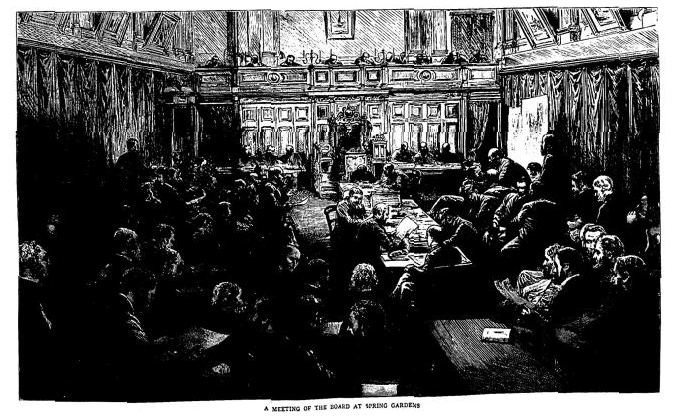
A meeting of the Metropolitan Board at Spring Gardens (from "The Graphic", 12 May 1888)
The Metropolitan Board of Works (MBW) was the principal instrument of London-wide government from 1855 until the establishment of the London County Council in 1889. Its principal responsibility was to provide infrastructure to cope with London's rapid growth, which it successfully accomplished. It covered what is now termed Inner London.
The board was created by the Metropolis Management Act 1855 which also created a second tier of parish vestries and district boards. The members of the Metropolitan Board were not directly elected but were nominated by these lower tier authorities and by the Corporation of London. This lack of accountability made it unpopular with Londoners, especially in its latter years when it fell prey to corruption.
Activities
Road improvements
The 1855 Act gave the board the power to "make, widen or improve any Streets, Roads or Ways for facilitating the Passage and Traffic between various Parts of the Metropolis". However, where the cost of any such improvement exceeded £50,000 an application had to be made to the the Commissioner of Public Works and where it exceeded £100,000 the permission of parliament needed to be obtained. Major improvements, therefore, required the passing of a private act of parliament. The following are the principal road schemes that the MBW undertook:
The Covent Garden Approach and Southwark and Westminster Communication Act, 1857 (c.cxv) authorised the construction of two new roads:[1]
- "a spacious and convenient Communication... between St Martin's Lane, at its intersection by Long Acre and Cranborne Street in the Parish of St Martin in the Fields, and the North West end of King Street, Covent Garden, in the Parish of St Paul Covent Garden."
- "a new Street... from Blackfriars Road in the Parish of Christchurch in the County of Surrey to High Street in the Borough of Southwark."
The "Covent Garden Approach" was built in 1859-61. Originally named New King Street, it was renamed as Garrick Street in 1864 following a request by the Garrick Club, who had relocated to a new premises there.[2] [3]
The "Southwark Improvement" was completed in 1864 as Southwark Street.[4]
Chairmen and chief officers
The work of the board was administered by a chairman and various chief officers each heading a department.
Chairmen
The office of chairman of the Metropolitan board was a full-time salaried position. The chairman had responsibility for supervising the activities of the board and was empowered to appoint temporary staff as needed for special projects or prior to permanent contracts being issued by one of the chief officers.
- John Thwaites (knighted in 1865), 1855 - 1870 (died in office)
- James McNaughten McGarel-Hogg (created Baron Magheramorne in 1887), 1870 - 1889
Accountant to the Board (Head of Accountant's Department)
- George Sidney Hatton 1856-64
- Edward Hughes 1864-69
- Arthur Gunn 1869-89
Chemist to the Board (Head of Chemical and Gas Department)
In 1868 the MBW was given the duty of testing the quality of gas supplied by the various private gas companies in London. The board had already been charged with inspecting all gas meters in the Metropolis outside the City of London in 1861. While the board initially used consultants, a permanent post was deemed necessary in 1870.
- Thomas William Keates Snr. 1870-82
- William Joseph Dibdin 1884-89 (had been acting head of department 1882-84)
Clerk to the Board (Head of Clerk's Department)
The clerk initially had both administrative and legal duties: he had to attend all meetings of the board, keep minutes and provide legal advice. In 1859 the legal work was delegated to a standing counsel: a separate solicitor's department in 1861. From 1872 the clerk's department became responsible for the administration of the board's parks and open spaces, with the exception of building work which was the responsibility of the architect's department.
- Edmund Humphrey Woolrych 1856-59 (became standing counsel)
- John Pollard 1859-72
- John Ebenezer Wakefield 1872-89
Engineer to the Board (Head of Engineer's Department)
- Joseph William Bazalgette (previously engineer to the Metropolitan Commission of Sewers, knighted 1875) 1856-89
Chief Fire Officer (Head of Metropolitan Fire Brigade)
On 1 January 1866 the MBW became responsible for protecting life and property in London from fire. The board took over the firefighters, equipment and stations previously maintained by the various insurance companies and parish vestries, which were formed into a single Metropolitan Fire Brigade.
- Captain Eyre Massey Shaw 1866-89
Clerk of Rates (Head of Rates Department)
The Rates Department was abolished and absorbed into the Accountant's Department in 1865. This followed a failure to properly administer the collection of rates revealed by an enquiry. Nevertheless, Thomas Coggin retained his title and position within the Accountant's Department until the board's abolition.
- Thomas Coggin 1856-65
Solicitor to the Board (Head of the Solicitor's Department)
The solicitor's department was created in 1861. It dealt with all the legal work of the board including conveyancing, compensation and the drafting of parliamentary bills.
- William Wyke Smith (1861-78)
- Reginald Ward (1878-89)
Standing Counsel
The office was created in 1859 on the suggestion of the clerk, who ssubsequently adopted the post. On his retirement in 1861 the office was abolished with the creation of a solicitor's department.
- Edmund Humphrey Woolrych (1859-61)
Superintending Architect of Metropolitan Buildings (Head of Architect's Department)
- Frederick Marrable 1856-61
- George John Vullaimy 1861-86
- Thomas Blashill 1886-89
See also
- List of Members of the Metropolitan Board of Works
- List of electing authorities to the Metropolitan Board of Works
Archives
Details of the locations of the MBW's archives can be found here [1] and here [2].
The Minutes can be found here [3].
References
- ↑ Public General Acts passed in the Year 1857.
- ↑ Victoria Glenddining (2011). Trollope. Random House.
- ↑ "Current Events". The Examiner. 16 July 1864.
- ↑ Southwark Street. Survey of London: volume 22: Bankside (the parishes of St. Saviour and Christchurch Southwark) (1950).